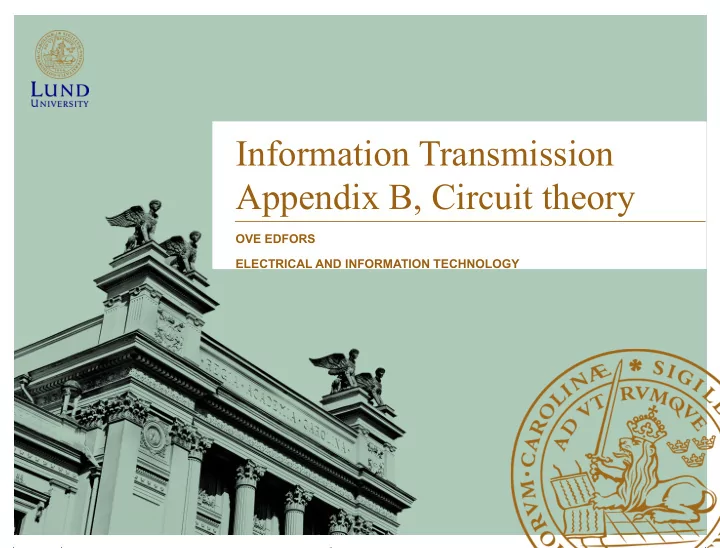

Information Transmission Appendix B, Circuit theory OVE EDFORS ELECTRICAL AND INFORMATION TECHNOLOGY
Learning outcomes After this lecture the student should Know the properties of, and be able to perform basic – calculations with, resistors, inductors and capacitors Know how resistors, inductors, and capacitors, behave when – sinusoidal signals are applied. Know Kirchhoff's voltage and current laws and understand – how they are applied to perform basic calculations on electronic circuits. Understand the impedance concept and how to caclculate the – total impedance of impedances connected in serial or parallel
Resistors, Inductors, Capacitors
user:oomlout/ Wikimedia Commons Resistors Does not depend on frequency.
FDominec/Wikimedia Commons/CC-BY-SA-3.0 Inductors Depends (increases) with frequency.
Eric Schrader/Wikimedia Commons/CC BY-SA 2.0 Capacitors Depends on (decreases with) frequency.
Impedance
Impedance
Kirchhoff’s current law
Kirchhoff’s voltage law
Example 1 What is i 1 , i 2 , i 3 , v 1 , v 2 , v 3 ?
Serial impedance
Example 2 What is v(t) ?
Parallel impedances What is the equivalent parallel impedance?
Parallel impedances Often we have only two impedances in parallel
Split of voltage and current
Summary Resistors, inductors & capacitors ● We can apply Ohm's law, also for inductors and capacitors, by – using and in place of ”resistance”. Impedance is the relation between voltage and current (often – from a combination of resistors, inductors and capacitors). Kirchoff's laws (general) ● Current law : At all times, the sum of all currents into a node – most equal the sum of currents leaving the node. (Charge can't accumulate in a node.) Voltage law : At all times, the sum of voltages around – any closed loop in a circuit must be zero. Typical circuits (special cases) ● Serial and parallel impedance – Split of voltage and current –
Recommend
More recommend